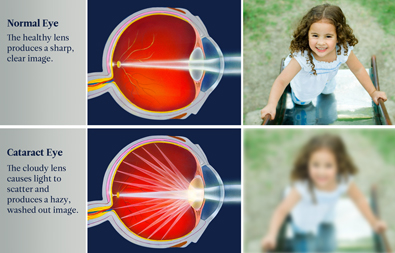Cataracts are a leading cause of vision loss in the world. Fortunately, loss of sight is usually reversible with the most common (and extremely quick and safe) surgical procedure performed on older Americans. Don’t let poor vision cloud your ability to see life to the fullest—educate yourself about cataracts and decide if it’s time for an eye exam.
1. What is a cataract?
Cataracts develop with time, like age spots and wrinkles. Six out of 10 people over age 60 and eight out of 10 people over age 80 have a cataract. Mark Freedman, MD, senior partner at Eye Care Specialists, a leading ophthalmology practice that has cared for more than 125,000 Wisconsinites at offices in Milwaukee, Wauwatosa and West Allis, explains, “A cataract is the clouding of the natural lens located inside the eye behind the pupil. This lens works like a camera lens—focusing light onto the retina at the back of the eye to form the images you see. As you age, protein in the lens may clump together and start to cloud. This is called a ‘cataract.’ As the clouding advances, it can blur or fog vision to the point of inhibiting day-to-day functioning. Depending on the type of cataract, the clouding may take years or just months to progress.”
2. What are the symptoms?
“Some people believe that losing your vision is a fact of life as you grow older. This isn’t true. In reality, the vision loss is often caused by the gradual clouding and yellowing of the lens inside your eye as it forms a cataract,” says Brett Rhode, MD, Head of Ophthalmology at Aurora Sinai Medical Center and partner at Eye Care Specialists. In addition to having regular, comprehensive, dilated eye exams every two years after age 40, Rhode advises people to schedule an eye exam if they notice:
• Foggy, fuzzy, blurred or double vision
• Sensitivity to light and glare
• “Starbursts” around lights
• Holding items closer to view
• Needing brighter light to read
• Fading or yellowing of colors
• Difficulty judging stairs or curbs
• Difficulty seeing to drive at night
• Vision changes affecting the ability to do tasks
• Glasses and prescription changes don’t help
3. How do you get rid of a cataract?
“There are no drugs, drops, glasses or exercises that can prevent or cure cataracts,” says Daniel Paskowitz, MD, PhD, an ophthalmologist with credentials from Harvard and Johns Hopkins. “Once an eye exam confirms the diagnosis of a cataract, the only effective treatment is to make an opening in the eye, surgically remove the cloudy lens (cataract), and replace it with a prescription lens implant that acts like an internal contact lens to restore focusing ability, side vision, and depth perception.”
4. When should you have surgery?
Eye surgeon Dr. Michael Raciti advises, “It’s not necessary to wait to remove a cataract until it’s so ripe that almost all vision is blocked. In fact, if you wait too long, it can grow so dense that the operation becomes riskier and more difficult. I tell patients that if the cataract is preventing you from doing tasks, new glasses won’t improve clarity, and no other conditions exist which would negate the benefits of removal (like severe macular degeneration), then it’s time for surgery.” Studies have shown that prompt cataract removal actually reduces the risk of falls, injuries and car accidents and increases physical and emotional well-being and life span.
5. What happens during and after surgery?
Daniel Ferguson, MD, an ophthalmologist with thousands of cases under his surgical cap explains the typical cataract procedure, “The surgery is performed at an outpatient facility using local anesthesia (often just drops to numb the eye). A no-stitch, self-sealing micro-incision is then made and a probe is inserted that uses high frequency ultrasound to gently break up and vacuum out the cataract. Finally, a lens implant is inserted through the same tiny opening and placed permanently inside the eye where the natural lens used to be. The procedure itself usually takes only about 15-30 minutes and total time at the outpatient surgery center is about 2-3 hours. After surgery, patients go home and resume normal activities within hours; and their vision noticeably improves within days. In fact, most people are so pleased with seeing things brighter and clearer, that they can’t wait to have their other eye done. And, studies have proven that prompt cataract removal actually reduces the risk of falls, injuries and car accidents and increases optimism, physical and emotional well-being, and life span.”
6. Are cataracts preventable?
“Cataracts cannot be prevented. Cataract development may be delayed or slowed, however, by wearing sunglasses and hats with brims, eating a balanced diet high in healthy nutrients (vitamins, minerals and antioxidants) and low in fat and sugar, avoiding smoking and excessive alcohol intake, and keeping your blood sugar under control if you have diabetes,” explains Dr. David Scheidt, past-president of the Milwaukee Optometric Society.
FREE Booklets & Information
Prompt diagnosis and treatment are vital to protecting and preserving vision. Get checked for cataracts and other sight-threatening conditions. If you don’t have an eye doctor, call 414-321-7035 for free educational booklets (on cataracts, glaucoma, diabetes, or macular degeneration) and information about scheduling a comprehensive eye exam ( typically covered by Medicare and most insurances) at Eye Care Specialists’ offices on 7th & Wisconsin Avenue, Mayfair Road across from the mall, or 102nd & National Ave. They also offer detailed educational information at www.eyecarespecialists.net.
More from Your Stories
- Ebenezer's Pareting Tip: What is Helicopter Parenting?
- Build a Lego City!
- Anansi Puppet Story and Craft
- MCW researchers to study airway management in out-of-hospital cardiac arrest
- Milwaukee Backgammon Club to hold 3 tournaments in August!
- 4th Annual Cruisin’ the Grove Scheduled for Aug. 7
- MCW awarded $1.9 million to investigate disease prevention utilizing slime mold
- Dublin the Fun Partner Promotions Make Milwaukee Irish Fest Even More Affordable
- September Fashion Show in Washington County
- Back to School...BBB Reminds You to Shop Smart!












